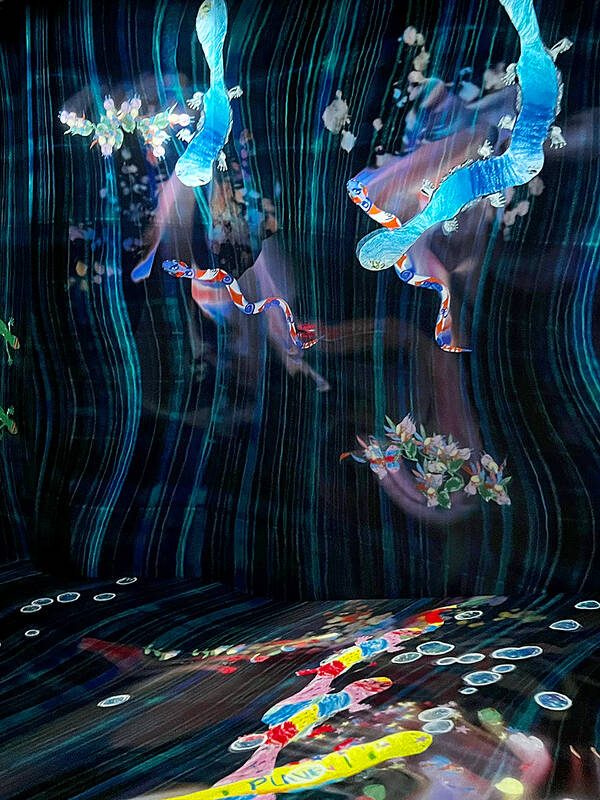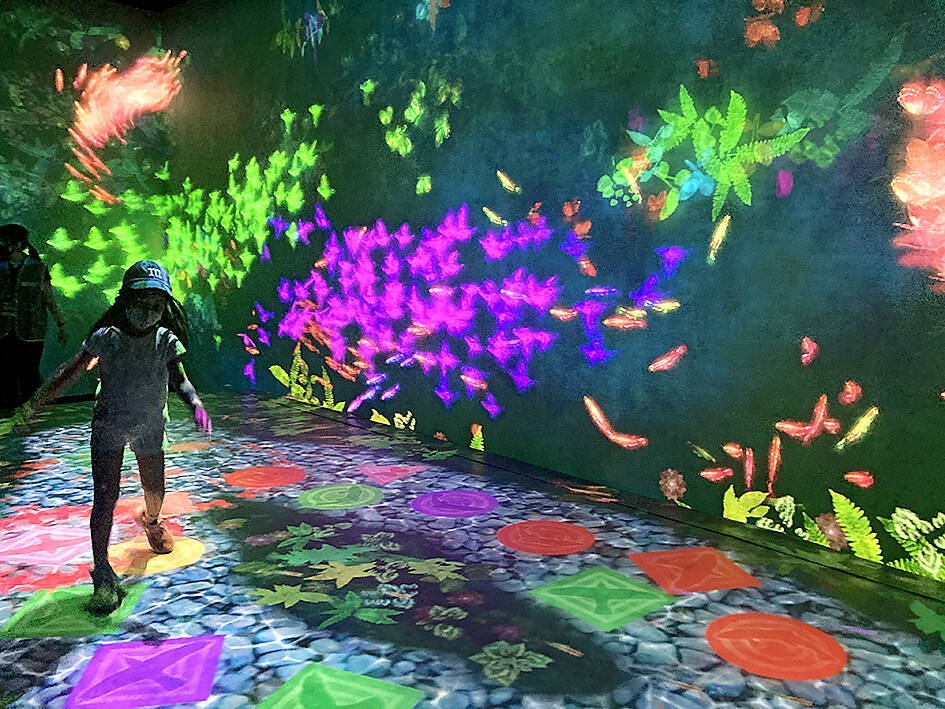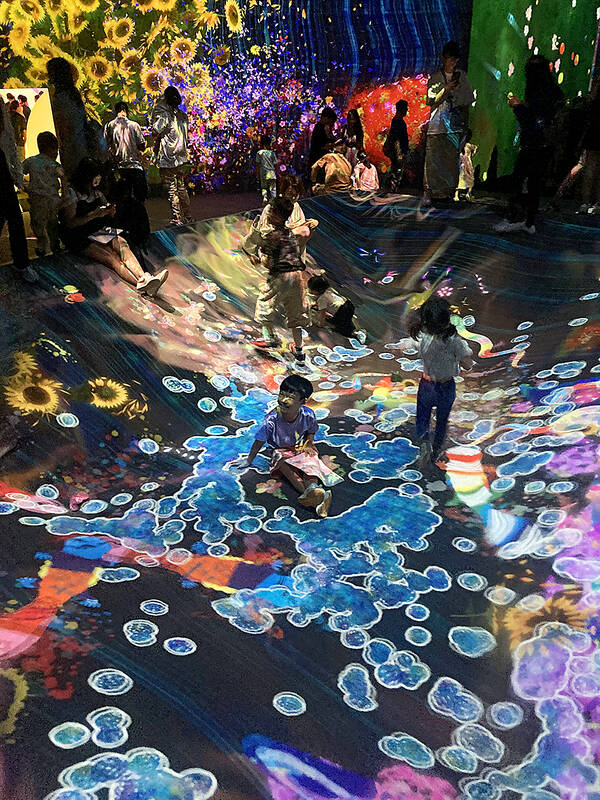Obnoxious camera-wielders block live concerts; cinemas are lit by furious screen tappers; museums become photoshoots; the Mona Lisa has been reduced to a background prop. Were you even there if you didn’t take a picture?
One art exhibition, however, embraces the Instagram of it all. TeamLab art exhibitions allow visitors to interact with playgrounds of light, color and sound as a whimsical photo opportunity.
TeamLab is an international art collective that started in Japan and has expanded globally from Sydney to Saudi Arabia. Their mission: “to navigate the confluence of art, science, technology and the natural world.”

Photo: Hollie Younger
Taipei hosted a teamLab pop-up in 2022, drawing over 300,000 visitors. This year’s exhibition, on view until Oct. 13 at Shilin’s National Taiwan Science Education Center, is a multi-room, multi-sensory feat of engineering and state-of-the-art design that focuses on “collaborative creation (co-creation),” where the guests work together as artists, designing and creating the world around them.
Like the Willy Wonka’s Chocolate Factory of digital art, the floor undulates below, blooming flowers at our footprints; we place our hands on the screens and tiny dancing cartoon people climb up to greet us; melodies symphonize as our bodies bump against glowing orbs in the “Light Ball Orchestra.”
Every motion of every visitor dictates the visual and auditory simulations, creating a trippy, sensory-altering environment so immersive that adults are reduced to the same wide-eyed wonder as their children.

Photo: Hollie Younger
In a darkened alcove, we’re invited to color in an amphibian, butterfly or flower with oil pastels. Staff scan and upload our designs to the art motherboard, and our scribbles instantly enter the third dimension, scuttling and slithering into the main hall.
My rainbow lizard eats my friend’s David Bowie-inspired frog, multiplying and scattering across the walls. The drawings interact symbiotically, squished underfoot or devoured by another doodle further up the food chain, as we chase our group’s salamanders and snakes around the room.
CHILD FRIENDLY

Photo: Hollie Younger
TeamLab is very child-friendly, designed to bring out everyone’s inner child, despite intermittent pleas of weary attendants to “Stop running!” and “Be careful!”
A 20-foot slide of animated fruit and a hop-scotch of stepping stones over a twinkling river attract old and young to whoosh down and leap across.
But while visually stunning, the attraction led me to reflect on the influence of Instagram culture and digital narcissism as much as I appreciated artistic digitalism.
In the main hall, sunflowers bloom across LED screens, ostriches comprised of forget-me-not bouquets dash past, the light undulates purple then blue — and models strike editorial poses for professional cameras; a mother and daughter duo hold up peace signs for a cutesy selfie. Even Kim Kardashian, the Instagram queen herself, has used a Teamlab attraction for a photoshoot.
Another room sees children color in planes, trains and automobiles — then control and observe their movements via tablet devices, eyes once again locked on screens.
One exhibit features inflated beach balls designed to change color and create sound upon organic movement and guest interaction, although visitors seem more concerned with switching them pink for the perfect photo prop.
Ironically, the teamLab Future Park Web site claims that, “large numbers of people are addicted to smartphones. Their brains may be connected, but their bodies are isolated.” But is this social media playground the savior of human connection?
In the 2019 book Advancing Humanity: teamLab’s Borderless World, teamLab founder Toshiyuki Inoko said he dislikes the crowds in front of the Mona Lisa as the art isn’t interactive. Once the space changes with the experiences of others, their existence actually enhances the artwork.
Crowds with cameras are still annoying, pulling visitors out of immersive experiences and into shallower waters. But it makes for fantastic free marketing.
And, admittedly, my Instagram story looked great last weekend.

The depressing numbers continue to pile up, like casualty lists after a lost battle. This week, after the government announced the 19th straight month of population decline, the Ministry of the Interior said that Taiwan is expected to lose 6.67 million workers in two waves of retirement over the next 15 years. According to the Ministry of Labor (MOL), Taiwan has a workforce of 11.6 million (as of July). The over-15 population was 20.244 million last year. EARLY RETIREMENT Early retirement is going to make these waves a tsunami. According to the Directorate General of Budget Accounting and Statistics (DGBAS), the

Last week the story of the giant illegal crater dug in Kaohsiung’s Meinong District (美濃) emerged into the public consciousness. The site was used for sand and gravel extraction, and then filled with construction waste. Locals referred to it sardonically as the “Meinong Grand Canyon,” according to media reports, because it was 2 hectares in length and 10 meters deep. The land involved included both state-owned and local farm land. Local media said that the site had generated NT$300 million in profits, against fines of a few million and the loss of some excavators. OFFICIAL CORRUPTION? The site had been seized

Sept. 15 to Sept. 21 A Bhutanese princess caught at Taoyuan Airport with 22 rhino horns — worth about NT$31 million today — might have been just another curious front-page story. But the Sept. 17, 1993 incident came at a sensitive moment. Taiwan, dubbed “Die-wan” by the British conservationist group Environmental Investigation Agency (EIA), was under international fire for being a major hub for rhino horn. Just 10 days earlier, US secretary of the interior Bruce Babbitt had recommended sanctions against Taiwan for its “failure to end its participation in rhinoceros horn trade.” Even though Taiwan had restricted imports since 1985 and enacted

Take one very large shark, a boat (we’re gonna need a bigger one of those) and a movie that ran way over budget and you’ve got all the ingredients of a career-making film for one of Hollywood’s most successful directors. Now fans of Jaws — Steven Spielberg’s terrifying thriller about a man-eating shark — can re-live the movie as it celebrates its 50th anniversary in an exhibition at the Academy Museum in Los Angeles. “The film certainly cost me a pound of flesh, but gave me a ton of career,” Spielberg told reporters as he toured exhibits of props and memorabilia